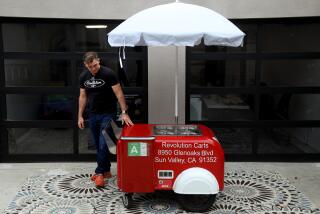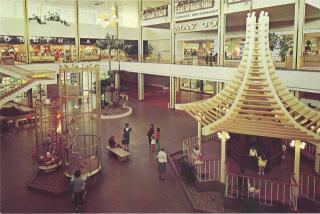A Boost for Urban Shoppers
The mightiest retailer in the world, Wal-Mart, looked like the last, best hope for the vacant, long-troubled anchor spot at Crenshaw Plaza -- if only it would fit.
Wal-Mart Stores Inc. and other big-box discounters favor the wide-open spaces of suburban shopping centers, using 18 or more acres for a store and parking lot. The empty department store at Baldwin Hills Crenshaw Plaza in central Los Angeles, by comparison, crams the equivalent of two acres onto five floors.
But in January, Wal-Mart plans to open a multilevel store at Crenshaw Plaza -- and itâs all possible because of a 50-year-old machine that can best be described as an escalator for shopping carts.
The device, common in Europe but relatively new in the United States, is allowing Wal-Mart, Target Corp. and other retailers to bring multistory versions of their giant discount stores to urban areas that have struggled to provide the kind of shopping options the suburbs long have enjoyed.
âThereâs no other way to build a Wal-Mart store in a neighborhood like Crenshaw,â said company spokesman Robert McAdam. âThereâs just not enough land to make it work. You have to take something over, and the only way to make that work is by using a cart escalator.â
It wouldnât be the first time that technology helped change the urban landscape. Elevators made the high-rise possible, sending cities into the sky. Freeways paved the way for suburban development, which in turn left swaths of inner-city areas empty and blighted.
The cart conveyor systems, to hear some boosters and urban planning experts tell it, will help fuel a new phase, bringing commerce back to the urban core.
âWill this little machine change everything? No. Does it get over a major obstacle for city development? Absolutely,â said Richmond McCoy, president of UrbanAmerica, an inner-city real estate development company. âIt can be an anchor for further economic investment, and thatâs what has to happen for these cities to change.â
David Pelczmann, a onetime conveyor salesman, believed in the machinesâ potential enough to buy the German company that makes them.
âThis is not a sexy product -- itâs nuts, bolts, steel and doesnât talk,â said Pelczmann, owner of Darrott Inc. âBut it is fundamental to the redevelopment of the urban areas. It is the only way you are going to get rid of the desolation left by the migration to the suburbs.â
Most big discount chains got their start outside cities. As the competition and costs in the suburbs grew, however, the retailers recognized that urban areas -- with their dense concentration of consumers -- represent a golden, untapped market.
Still, entering urban environments posed significant challenges: The stores would have to be multilevel because of limited space, and yet shoppers would have to be able to travel easily between floors with bulky carts.
Discount retailers depend on people piling in as many goods as possible to make up for slim profits on individual items. Without carts, customers wonât buy as much.
Target tried to use king-size elevators to accommodate carts when the retailer opened a Pasadena store in 1994. But company executives soon realized that elevators have limited capacity and subject shoppers to annoying waits.
The cart conveyor systems, by comparison, speed shoppers and their carts between floors along parallel tracks. Resembling side-by-side escalators, the escalator and cart conveyor combination also allows shoppers to maintain a view of the storeâs surroundings -- key to their being able to move quickly to their destination after disembarking.
âItâs kind of like a ride at Disneyland,â said Michele Breslauer, a 36-year-old lawyer, as she put her cart on the conveyor at Target in Van Nuys. âOnce you do it, youâre fine. I think itâs great because the elevators are a hassle.â
Added Adriana West, 30, of Tarzana: âYou donât have to wait -- you just hop right on.â
Some civic planners contend that big-box stores are no panacea for urban ills, because they drive smaller merchants out and primarily offer low-paying work.
However, developers and others say the giant discounters bring sales tax revenue, low-cost goods and jobs to areas that need them.
By most accounts, the credit for bringing the cart conveyor to the U.S. belongs to IKEA. The Sweden-based furniture seller installed its first U.S. system in its Carson store in 1993.
But it was Target, hoping to build a competitive advantage by moving into urban markets, that saw the potential for using the machines to transform older buildings into modern discount stores.
âWe knew these areas were underserved, and we knew that in order for us to grow, weâd have to be in some of those areas,â Targetâs communications chief, Carolyn Brookter, said. âWe didnât want to bury our heads and say we couldnât figure it out.â
California became the top laboratory, offering dense pockets of consumers and cities littered with empty shells from department store mergers and bankruptcies.
Target opened its initial cart conveyor-equipped store in 1995, in a former department store in La Mesa, near San Diego.
After testing its first multilevel store in Pasadena, Target was eager to open others but concluded that the slow and clunky cart elevators were not up to the task.
The companyâs architects briefly considered ramp conveyors, used at some grocery stores, in which the customers ride behind their carts on a moving incline. But the ramp conveyors are slower and require more space than the stair-stepped escalator systems.
It was an elevator consultant in California who pointed Target architects to the escalator-like contraption, called a Vermaport, at IKEAâs Carson store.
Though almost unheard of in the United States, Vermaports have been sold since 1956 throughout Europe and Asia, where population density and limited space bumped up against the modern retail megastore.
Gary Newhouse, an architect and design project manager with Target, was all but sold on the idea after he spent an afternoon at IKEA, watching customersâ easy acceptance of the system.
He became a believer during a trip to Europe, and he consulted Pelczmann, then the U.S. agent for Transport Technik (now Darrott), which makes the Vermaport.
Pelczmann had sent pictures and a description of the Vermaport to nearly every major supermarket chain. But his phone hadnât rung before Target came calling.
Newhouse, armed with photos, cost comparisons and design plans, had little trouble persuading Targetâs senior management back in Minneapolis to take a chance on a one-store test. But there were hitches.
First, the company couldnât find an inspector to approve the Vermaport, because neither the elevator inspector nor the local building engineer could decide how to classify the contraption. There also was a need to make changes to meet U.S. safety standards.
Target added two swinging plastic panels to keep children from wandering onto the belt and placed signs directing parents not to leave their children in the cart while it was on the conveyor.
On the storeâs opening day in 1995, the question was whether shoppers would accept the odd-looking machines -- and what Target would do if they didnât.
âIt was nerve-racking,â Newhouse said. âPeople understood how elevators work, they understood how escalators work. Would they understand this?â
Target stationed clerks at the top and bottom of each escalator to demonstrate and to keep children and strollers off the machines. For most people, Newhouse said, the Vermaport was a fun new display. Many shoppers stopped just to watch the merchandise-filled carts ride up and down.
âIt opened up all sorts of possibilities,â Newhouse said. âWe moved, and we moved fast.â
After La Mesa, Target quickly opened two Bay Area stores with cart escalators. From there, Target introduced the system around the country, opening stores in sites that other large-format retailers might never have considered, including Van Nuys, Eagle Rock, three stores in Washington, D.C., and one in Queens, N.Y. It now has 22 stores equipped with what Target calls âcartveyors.â
Other retailers followed suit.
Wal-Mart opened its first multilevel store in 1998, taking over the old Broadway store in Panorama Cityâs nearly 50-year-old Panorama Mall and installing the companyâs first in-store cart conveyor system.
The company next year will roll out its multilevel model, installing cart conveyors at the new Wal-Mart in Crenshaw and at four other sites around the country.
Sears, Roebuck & Co.âs Great Indoors and Bed Bath & Beyond Inc. also have slowly begun trying out multilevel stores and cart conveyors.
By 2000, Darrott had doubled the number of Vermaports sold in the U.S., with orders for 48, Pelczmann said. That also was the year a Wisconsin company, Pflow Industries Inc., introduced its own cart conveyor system for customers including Target.
Though sales are slow for the systems, which can cost several hundred thousand dollars each, urban planners and others are heartened that the shift is happening at all.
âRetailers werenât going to come; they wrote the cities off,â said Larry Kosmont, president of Kosmont Cos., a real estate advisory and development services firm that focuses on urban areas.
âNow they have the technology to make those stores work for their customers. It opens up the possibilities.â
More to Read
Inside the business of entertainment
The Wide Shot brings you news, analysis and insights on everything from streaming wars to production â and what it all means for the future.
You may occasionally receive promotional content from the Los Angeles Times.










